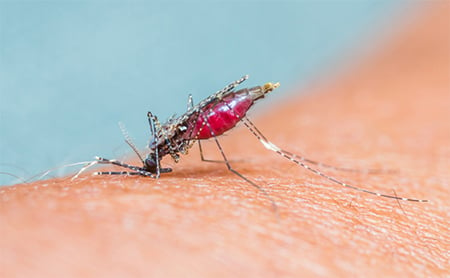What Health Officials Should Know About Locally Acquired Malaria Cases in Florida and Texas
June 28, 2023 | Courtney Youngbar, Kathy Dolan

Key Takeaways
- The risk of locally acquired malaria is low in the U.S.
- Health department experts monitor and respond to mosquito activity daily to reduce the risk of vector-borne illness.
- Effective treatment for malaria is readily available through hospitals and other healthcare providers.
- All cases reported were P. vivax, which is less likely to cause severe disease.
Late on June 26, 2023, five cases of locally acquired (i.e., non-travel related), mosquito transmitted malaria were reported from two states: Florida and Texas. Currently no evidence suggests the cases in the two states are related. In both states, all affected people have been treated and are either improving or fully recovered.
In Florida, four cases within close geographic proximity were identified, and active surveillance for additional cases remains ongoing. Florida officials have implemented mosquito surveillance and vector control measures in the affected area. The last locally acquired outbreak in Florida occurred in 2003. In Texas, one case was identified, and surveillance for additional cases, as well as mosquito surveillance and control, are ongoing. The last locally acquired Texas case occurred in 1994.
The likelihood for local transmission to be established in the United States depends on availability of vectors, suitability of climate and environmental conditions (like allowing Anopheles mosquito to survive for most of the year) for malaria vectors and the Plasmodium parasite, which can both be influenced by the changing climate. Higher average temperatures may increase mosquito populations in areas where they are typically present and make locations not previously hospitable to vectors vulnerable to emerging infections.
What State and Territorial Health Officials (S/THAs) Can Do
- Consider developing strategies for rapid identification, prevention, and control.
- Outreach to communities to provide education on the importance of precautions for malaria and other diseases before traveling internationally to an area where malaria occurs.
- Provide education to communities to prevent mosquito-borne illness including breeding site reduction strategies.
- Support clinicians to identify hospitals in areas of active cases or transmission.
- A dear colleague letter from the health official to providers in the community.
- Coordination with mosquito control programs to enhance mosquito surveillance.
- Assessing capacity of hospitals and laboratories to rapidly diagnose and treat malaria. This should include the ability to rapidly acquire and provide treatment (see the Recommendations for Hospitals and Laboratories section of the recent CDC health alert).
- It is essential that outreach and educational materials are available in multiple languages.
In the short term, S/THAs can contact CDC’s Malaria Branch (malaria@cdc.gov; 770-488-7788) during regular business hours or CDC’s Emergency Operations Center (eocreport@cdc.gov; 770-488-7100) outside of regular business hours for assistance with recommendations and testing.
To prepare for the future, health officials should consider critical infrastructure needs for vector surveillance and control. These include training that covers public health law and emergency management training, messaging about the safety of insecticides (particularly in emergency situations when aerial spraying is needed), and more resources or strategies to promote behavior change among the public to prevent mosquito bites.
There is no one-size-fits-all control strategy for mosquitoes; different species require different interventions. S/THAs have an important role in educating and collaborating with local programs on the best strategies for mosquito control.
Important Resources
- ASTHO Toolkit: Public Health Confronts the Mosquito: This updated report provides guidance to assist local, state, and territorial mosquito control programs in developing and maintaining an effective mosquito control infrastructure to meet the ongoing challenges surrounding and emergences of vector-borne diseases.
- ASTHO Policy Statement on Climate and Extreme Weather Events
- States Can Lead on Mitigating the Effects of Climate Change (ASTHO Health Policy Update, April 2023)
- ASTHO Story Map: What Does a New Health Official Need to Know About Vector-Borne Disease
- CDC: Malaria
- CDC: Treatment of Malaria: Guidelines for Clinicians (United States)
- CDC: Parasites—Continuing Education—Malaria 101 for the Healthcare Provider
Background on Malaria
Malaria is a mosquito-borne disease caused by any of five species of protozoan parasite: Plasmodium falciparum, P. vivax, P. malariae, P. ovale, and P. Knowlesi.
- Malaria may cause flulike symptoms, including fever, chills, and headache, but can lead to death if left untreated.
- Malaria mostly occurs in tropical and subtropical areas of the world.
- Before this week, locally-acquired cases of malaria have not been reported in the United States since 2003.
- Malaria used to be endemic in parts of the U.S. but was eliminated in the 1950s.
- Worldwide, malaria has a huge impact. Considered one of the deadliest diseases and one of the world’s greatest public health problems, an estimated 627,000 people died of malaria in 2020. It is a serious and potentially fatal disease.
- Malaria is transmitted through the bite of a female Anopheles species mosquito. In the U.S., these include An. freeborni and An. Quadrimaculatus, which are found throughout the U.S., mainly along the west coast and eastern region of the United States.
- The majority of malaria cases in the U.S. occurs in people who have traveled to regions/countries with ongoing malaria transmission/are imported (acquired out of the U.S.)
- Rarely, malaria can be transmitted from mother to fetus during pregnancy or from mother to baby at birth (congenital malaria), through blood transfusion or organ transplantation, or through unsafe needle-sharing
- While the risk of locally acquired malaria in the U.S. remains low, Anopheles mosquito vectors are capable of transmitting malaria if they feed on a person infected with malaria.
- Why are we worried about it: the potential risk for the disease to re-emerge is present due to the abundance of competent vectors, especially in the southern states.